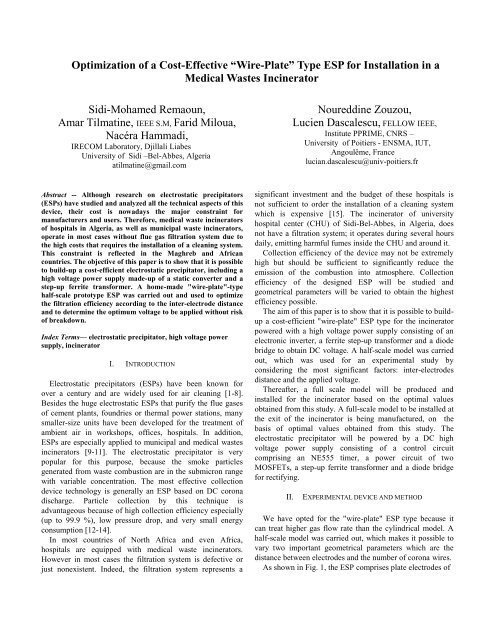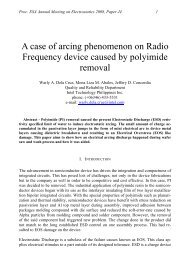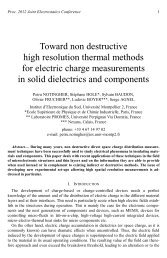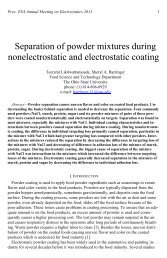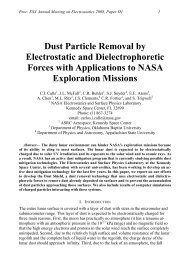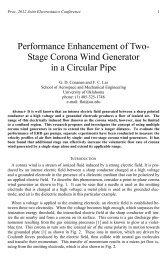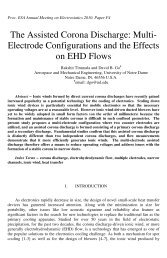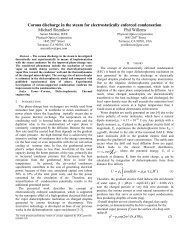Optimization of a Cost-Effective âWire-Plateâ Type ESP for ...
Optimization of a Cost-Effective âWire-Plateâ Type ESP for ...
Optimization of a Cost-Effective âWire-Plateâ Type ESP for ...
You also want an ePaper? Increase the reach of your titles
YUMPU automatically turns print PDFs into web optimized ePapers that Google loves.
<strong>Optimization</strong> <strong>of</strong> a <strong>Cost</strong>-<strong>Effective</strong> “Wire-Plate” <strong>Type</strong> <strong>ESP</strong> <strong>for</strong> Installation in a<br />
Medical Wastes Incinerator<br />
Sidi-Mohamed Remaoun,<br />
Amar Tilmatine, IEEE S.M, Farid Miloua,<br />
Nacéra Hammadi,<br />
IRECOM Laboratory, Djillali Liabes<br />
University <strong>of</strong> Sidi –Bel-Abbes, Algeria<br />
atilmatine@gmail.com<br />
<br />
<br />
Abstract -- Although research on electrostatic precipitators<br />
(<strong>ESP</strong>s) have studied and analyzed all the technical aspects <strong>of</strong> this<br />
device, their cost is nowadays the major constraint <strong>for</strong><br />
manufacturers and users. There<strong>for</strong>e, medical waste incinerators<br />
<strong>of</strong> hospitals in Algeria, as well as municipal waste incinerators,<br />
operate in most cases without flue gas filtration system due to<br />
the high costs that requires the installation <strong>of</strong> a cleaning system.<br />
This constraint is reflected in the Maghreb and African<br />
countries. The objective <strong>of</strong> this paper is to show that it is possible<br />
to build-up a cost-efficient electrostatic precipitator, including a<br />
high voltage power supply made-up <strong>of</strong> a static converter and a<br />
step-up ferrite trans<strong>for</strong>mer. A home-made "wire-plate"-type<br />
half-scale prototype <strong>ESP</strong> was carried out and used to optimize<br />
the filtration efficiency according to the inter-electrode distance<br />
and to determine the optimum voltage to be applied without risk<br />
<strong>of</strong> breakdown.<br />
Index Terms— electrostatic precipitator, high voltage power<br />
supply, incinerator<br />
I. INTRODUCTION<br />
Electrostatic precipitators (<strong>ESP</strong>s) have been known <strong>for</strong><br />
over a century and are widely used <strong>for</strong> air cleaning [1-8].<br />
Besides the huge electrostatic <strong>ESP</strong>s that purify the flue gases<br />
<strong>of</strong> cement plants, foundries or thermal power stations, many<br />
smaller-size units have been developed <strong>for</strong> the treatment <strong>of</strong><br />
ambient air in workshops, <strong>of</strong>fices, hospitals. In addition,<br />
<strong>ESP</strong>s are especially applied to municipal and medical wastes<br />
incinerators [9-11]. The electrostatic precipitator is very<br />
popular <strong>for</strong> this purpose, because the smoke particles<br />
generated from waste combustion are in the submicron range<br />
with variable concentration. The most effective collection<br />
device technology is generally an <strong>ESP</strong> based on DC corona<br />
discharge. Particle collection by this technique is<br />
advantageous because <strong>of</strong> high collection efficiency especially<br />
(up to 99.9 %), low pressure drop, and very small energy<br />
consumption [12-14].<br />
In most countries <strong>of</strong> North Africa and even Africa,<br />
hospitals are equipped with medical waste incinerators.<br />
However in most cases the filtration system is defective or<br />
just nonexistent. Indeed, the filtration system represents a<br />
<br />
Noureddine Zouzou,<br />
Lucien Dascalescu, FELLOW IEEE,<br />
Institute PPRIME, CNRS –<br />
University <strong>of</strong> Poitiers - ENSMA, IUT,<br />
Angoulême, France<br />
lucian.dascalescu@univ-poitiers.fr<br />
significant investment and the budget <strong>of</strong> these hospitals is<br />
not sufficient to order the installation <strong>of</strong> a cleaning system<br />
which is expensive [15]. The incinerator <strong>of</strong> university<br />
hospital center (CHU) <strong>of</strong> Sidi-Bel-Abbes, in Algeria, does<br />
not have a filtration system; it operates during several hours<br />
daily, emitting harmful fumes inside the CHU and around it.<br />
Collection efficiency <strong>of</strong> the device may not be extremely<br />
high but should be sufficient to significantly reduce the<br />
emission <strong>of</strong> the combustion into atmosphere. Collection<br />
efficiency <strong>of</strong> the designed <strong>ESP</strong> will be studied and<br />
geometrical parameters will be varied to obtain the highest<br />
efficiency possible.<br />
The aim <strong>of</strong> this paper is to show that it is possible to buildup<br />
a cost-efficient "wire-plate" <strong>ESP</strong> type <strong>for</strong> the incinerator<br />
powered with a high voltage power supply consisting <strong>of</strong> an<br />
electronic inverter, a ferrite step-up trans<strong>for</strong>mer and a diode<br />
bridge to obtain DC voltage. A half-scale model was carried<br />
out, which was used <strong>for</strong> an experimental study by<br />
considering the most significant factors: inter-electrodes<br />
distance and the applied voltage.<br />
Thereafter, a full scale model will be produced and<br />
installed <strong>for</strong> the incinerator based on the optimal values<br />
obtained from this study. A full-scale model to be installed at<br />
the exit <strong>of</strong> the incinerator is being manufactured, on the<br />
basis <strong>of</strong> optimal values obtained from this study. The<br />
electrostatic precipitator will be powered by a DC high<br />
voltage power supply consisting <strong>of</strong> a control circuit<br />
comprising an NE555 timer, a power circuit <strong>of</strong> two<br />
MOSFETs, a step-up ferrite trans<strong>for</strong>mer and a diode bridge<br />
<strong>for</strong> rectifying.<br />
II.<br />
EXPERIMENTAL DEVICE AND METHOD<br />
We have opted <strong>for</strong> the "wire-plate" <strong>ESP</strong> type because it<br />
can treat higher gas flow rate than the cylindrical model. A<br />
half-scale model was carried out, which makes it possible to<br />
vary two important geometrical parameters which are the<br />
distance between electrodes and the number <strong>of</strong> corona wires.<br />
As shown in Fig. 1, the <strong>ESP</strong> comprises plate electrodes <strong>of</strong>
60 cm<br />
Control circuit<br />
45 cm<br />
Input voltage<br />
220 AC<br />
Step-down<br />
Trans<strong>for</strong>mer<br />
220/24 V<br />
Rectifier bridge<br />
100<br />
cm<br />
Voltage<br />
Regulator<br />
LM7815<br />
NE555 Timer<br />
Mosfets driver<br />
UCC37322<br />
Power stage<br />
Fig. 1. The electrostatic precipitator<br />
dimensions 100 x 45 cm 2 whose number varies depending on<br />
the value <strong>of</strong> the inter-electrode distance. The ionizing<br />
electrodes are constituted by a row <strong>of</strong> 5 vertical wires <strong>of</strong> 0.1<br />
mm diameter (Fig. 2). The plates are connected to the frame<br />
<strong>of</strong> the <strong>ESP</strong>, this latter being grounded, while the wires which<br />
are connected to DC high voltage are isolated from the<br />
carcass using Teflon insulators.<br />
Smoke is produced within a container generated by burning<br />
rubber chips; a fume extractor fan is located downstream at<br />
the outlet <strong>of</strong> the <strong>ESP</strong>, having adjustable flow rate with<br />
maximum value <strong>of</strong> 1200 m 3 /h.<br />
The applied voltage was delivered by a commercial high<br />
voltage power supply, however, given its high cost, a homemade<br />
HV power supply is under construction. It is made<br />
using a static converter, a step-up ferrite core trans<strong>for</strong>mer and<br />
a rectifying diode bridge.<br />
Fig. 3 shows the block diagram <strong>of</strong> the high voltage power<br />
supply under construction. The power supply consists <strong>of</strong> a<br />
control circuit block, which aims to generate a high frequency<br />
square signal and a power block composed <strong>of</strong> two Mosfets<br />
controlled by the square signal. Input voltage is decreased to<br />
24 V using a step-down trans<strong>for</strong>mer 220/24 V, which is<br />
rectified and then fixed at a constant value <strong>of</strong> 15 V using a<br />
voltage regulator LM7815.<br />
High voltage stem<br />
Insulator ((teflon)<br />
Half-bridge <strong>of</strong><br />
2 Mosfets<br />
IRFP260<br />
Ferrite HV<br />
Trans<strong>for</strong>mer<br />
Fig. 3. Block diagram <strong>of</strong> the high voltage supply<br />
High voltage<br />
rectifier bridge<br />
This voltage (15V DC ), used to power a NE555 timer<br />
circuit, is trans<strong>for</strong>med into a square signal <strong>of</strong> adjustable<br />
frequency ranging between 10 and 100 kHz using a<br />
potentiometer. The square signal coming out <strong>of</strong> the timer is<br />
then amplified using a driver <strong>of</strong> Mosfets UCC37322. At the<br />
same time, a rectified and adjustable voltage (0-310 V), that<br />
feeds the primary <strong>of</strong> a step-up ferrite trans<strong>for</strong>mer <strong>of</strong> power<br />
1000 W, is trans<strong>for</strong>med in a high frequency signal by the<br />
Mosfets (IRF640) controlled by the timer square signal,<br />
thereby obtaining an adjustable high voltage output.<br />
The AC voltage is then rectified using a diode bridge. This<br />
power supply is not expensive because a ferrite-core step-up<br />
trans<strong>for</strong>mer is employed, which is much smaller and cheaper<br />
than conventional trans<strong>for</strong>mer (Fig. 4). The cost <strong>of</strong> this<br />
supply will not exceed 500 USD.<br />
10 cm<br />
Corona<br />
wire<br />
10 cm<br />
Support-frame<br />
Fig. 2. Ionizing electrode <strong>of</strong> the <strong>ESP</strong><br />
Fig. 4. HV ferrite trans<strong>for</strong>mer
1<br />
2<br />
<strong>ESP</strong><br />
3 5<br />
4<br />
6<br />
Filter pellets made <strong>of</strong> Polyester (air permeability<br />
100L/dm 2 /min, thickness 1.5 mm, resistance to temperature<br />
150 °C) were used to measure the efficiency.<br />
These filter samples were weighed using an electronic<br />
balance <strong>of</strong> 0.1 mg precision (KERN ALJ 200 – 4NM) be<strong>for</strong>e<br />
and after each experiment to determine the mass <strong>of</strong> retained<br />
smoke. The collection efficiency (η) was calculated using<br />
the following <strong>for</strong>mula:<br />
<br />
η %<br />
100 1<br />
<br />
out <br />
(1)<br />
<br />
<br />
m<br />
<br />
m <br />
in <br />
Fig. 5. Experimental setup. 1- Variac <strong>for</strong> flow control <strong>of</strong> the fan; 2 - fan;<br />
3-Multimeters; 4-Variac to control the high voltage; 5-high voltage power<br />
supply; 6-vacuum cleaner<br />
Electrical measurements <strong>of</strong> the electrostatic precipitator<br />
were per<strong>for</strong>med with the experimental device <strong>of</strong> Fig. 5.<br />
The current-voltage characteristic ( or I(V) curves ) <strong>of</strong> the<br />
<strong>ESP</strong> was determined by measuring the current produced by<br />
corona discharge as function <strong>of</strong> the applied voltage, until<br />
breakdown. The current was measured using a digital<br />
multimeter (Keithley 2000) placed in series to ground and the<br />
voltage was measured with a probe voltage <strong>of</strong> ratio 1:100<br />
(Metrix HT212).<br />
Collection efficiency measurement was conducted using<br />
the experimental setup <strong>of</strong> Fig. 5 according to the descriptive<br />
scheme shown in Fig. 6 [16]. A vacuum cleaner <strong>of</strong> 1200 Watt<br />
power is used to suck the flue gas upstream and downstream<br />
<strong>of</strong> the <strong>ESP</strong>, with the same flow rate adjusted to 25 L/min<br />
using a ball flowmeter, during a duration time <strong>of</strong> 10 seconds.<br />
with<br />
m in : mass <strong>of</strong> smoke collected upstream <strong>of</strong> the <strong>ESP</strong><br />
m out : mass <strong>of</strong> smoke collected downstream <strong>of</strong> the <strong>ESP</strong><br />
III. RESULTS AND DISCUSSION<br />
A. Electrical Characteristics <strong>of</strong> the <strong>ESP</strong><br />
At first, the evolution <strong>of</strong> corona discharge as a function <strong>of</strong><br />
the applied voltage ( I(V) characteristics ) was determined.<br />
Since the width <strong>of</strong> the precipitator remains unchanged,<br />
equal to 60 cm, each value <strong>of</strong> the inter-electrode interval d (d<br />
= 6 cm, d = 7.5 cm, d = 10 cm) corresponds to a different<br />
number n <strong>of</strong> ionizing electrodes (n = 5, n = 4, n = 3).<br />
The current-voltage characteristics obtained <strong>for</strong> the three<br />
configurations with positive polarity are shown in Fig. 7. The<br />
total current increases with the applied voltage if it exceeds a<br />
certain threshold value, until breakdown <strong>of</strong> the gaseous<br />
medium.<br />
Flue gas<br />
Dc High voltage<br />
Power supply<br />
Collecting<br />
electrode<br />
Corona wire<br />
Exit to a<br />
Chimney<br />
Gas exit<br />
<strong>ESP</strong> wire-plate<br />
Polyester<br />
Filter Pellets<br />
Vaccum<br />
Fig. 6. Descriptive schematic <strong>of</strong> the pump experimental setup<br />
Fig. 7. Characteristic I(V) <strong>of</strong> the <strong>ESP</strong>
Power (W)<br />
Efficiency (%)<br />
The current flowing through their inter-electrode space is a<br />
nonlinear function <strong>of</strong> the applied voltage. For a constant<br />
voltage, the discharge current <strong>of</strong> configuration d = 6 cm is<br />
much higher, this is related to the intensification <strong>of</strong> the<br />
average electric field and the large number <strong>of</strong> active<br />
electrodes.<br />
However, it is in this configuration that the breakdown<br />
voltage <strong>of</strong> the gas is the lowest, posing significant risks to the<br />
reliability <strong>of</strong> power supply. The variation <strong>of</strong> the average<br />
power as a function <strong>of</strong> the applied voltage is shown in Fig. 8<br />
<strong>for</strong> three configurations. At fixed voltage, the results showed<br />
again a high power consumption <strong>of</strong> the configuration<br />
d = 6 cm.<br />
B. Collection efficiency <strong>of</strong> the <strong>ESP</strong><br />
Upstream <strong>ESP</strong> 17 kV 20 kV 23 kV<br />
Downstream <strong>ESP</strong><br />
Fig. 9. Photographs <strong>of</strong> the filter samples<br />
Virgin sample<br />
The experimental study <strong>of</strong> the collection efficiency was<br />
per<strong>for</strong>med by varying the applied voltage <strong>for</strong> three values <strong>of</strong><br />
the inter-electrode distance (d = 6, 7.5 or 10 cm). The<br />
polyester filter samples removed upstream and downstream <strong>of</strong><br />
the <strong>ESP</strong> are shown in Fig. 9 <strong>for</strong> the case <strong>of</strong> d = 6 cm.<br />
As expected, the color <strong>of</strong> the filter sample, used to collect the<br />
smoke particles, changes depending on their location<br />
(upstream or downstream) and the level <strong>of</strong> the applied<br />
voltage. Upstream, filter samples recover a large amount <strong>of</strong><br />
particles, which significantly changes their color.<br />
Downstream <strong>of</strong> the <strong>ESP</strong>, the amount <strong>of</strong> collected particles<br />
is becoming smaller with increasing voltage. The photographs<br />
<strong>of</strong> the collecting electrodes be<strong>for</strong>e and after a long period <strong>of</strong><br />
gas treatment confirm also the qualitative efficiency <strong>of</strong> the<br />
<strong>ESP</strong> (Fig. 10).<br />
As shown in (Fig. 11) , the collection efficiency increases<br />
with the applied voltage in the three configurations.<br />
This is explained by the enhancement <strong>of</strong> the particle<br />
charging and drift process when the electric field is increased.<br />
That is the configuration d = 7.5 cm which <strong>of</strong>fers the best<br />
collection efficiency at constant voltage ( up to 90% in the<br />
available voltage range).<br />
210<br />
180<br />
150<br />
120<br />
90<br />
60<br />
30<br />
0<br />
d=6 cm d=7,5 cm d=10 cm<br />
10 13 16 19 22 25 28 31<br />
Applied voltage V (kV)<br />
Fig. 8. Variation <strong>of</strong> the power consumption <strong>of</strong> the <strong>ESP</strong> as a function <strong>of</strong><br />
the applied voltage<br />
Be<strong>for</strong>e<br />
100<br />
80<br />
60<br />
40<br />
20<br />
0<br />
After<br />
Fig. 10. Photographs <strong>of</strong> the collecting electrodes be<strong>for</strong>e and after gas<br />
treatment<br />
d=6 cm d=7.5 cm d=10 cm<br />
14 17 20 23 26 29 32<br />
Applied voltage V kV)<br />
Fig. 11. Variation <strong>of</strong> the efficiency according the applied voltage<br />
The collection efficiency increases gradually with the<br />
power consumption (Fig. 12). The configuration d = 7.5 cm<br />
nevertheless has a definite advantage because it has a lower<br />
energy cost <strong>for</strong> superior per<strong>for</strong>mance: 80% <strong>of</strong> the particles<br />
are collected <strong>for</strong> a power less than 20W.<br />
The <strong>ESP</strong> to be installed at the exit <strong>of</strong> the medical wastes<br />
incinerator is under construction (Fig. 13), its installation<br />
will be carried out according to the assembly shown in Fig.<br />
14.<br />
A turbine is used to suck the smoke from the incinerator<br />
and to convey it and pass through the <strong>ESP</strong>. The turbine must<br />
be adjusted at a defined rate to suck the flue gas and mainly<br />
The medical waste incinerators in hospital centers in<br />
Algeria particularly and in Africa in general work in most<br />
cases without filtration gases fumes. We have shown in this<br />
paper that these incinerators can be equipped with cost<br />
efficient "wire-to-plate" type electrostatic precipitators.
Efficiency (%)<br />
100<br />
90<br />
80<br />
70<br />
60<br />
50<br />
40<br />
30<br />
20<br />
10<br />
0<br />
d = 6 cm d = 7.5 cm d = 10 cm<br />
0 20 40 60 80 100 120 140 160<br />
Power ( W )<br />
Fig. 12. Variation <strong>of</strong> the efficiency according to consumed power<br />
A turbine is used to suck the smoke from the incinerator<br />
and to convey it and pass through the <strong>ESP</strong>. The turbine must<br />
be adjusted at a defined rate to suck the flue gas and mainly<br />
avoid «aspiration <strong>of</strong> fire flames", the setting being provided<br />
by a variable speed drive. The removal <strong>of</strong> the flue gas layer<br />
collected on the electrodes will be done by cleaning with<br />
water jet.<br />
IV. CONCLUSION<br />
Fig. 13. Overview <strong>of</strong> the <strong>ESP</strong> under construction<br />
Flue gas<br />
Filtred gas<br />
The medical waste incinerators in hospital centers in<br />
Algeria particularly and in Africa in general work in most<br />
cases without filtration gases fumes. We have shown in this<br />
paper that these incinerators can be equipped with cost<br />
efficient "wire-to-plate" type electrostatic precipitators. These<br />
<strong>ESP</strong>s will be fed by static converters and high voltage ferrite<br />
trans<strong>for</strong>mer. A half-scale electrostatic precipitator was built<br />
and tested in the laboratory. The filtration efficiency <strong>of</strong> the<br />
device is still not very high but should be sufficient to<br />
significantly reduce emissions from combustion into the<br />
atmosphere.<br />
<strong>ESP</strong><br />
INCINERATOR<br />
Turbine<br />
Fig. 14. Filtration system to be installed <strong>for</strong> the hospital wastes incinerator<br />
REFERENCES<br />
[1] H. J. White, Industrial Electrostatic Precipitation, Reading, Addison<br />
Wesley Publishing company, New York, 1963.<br />
[2] K. R. Parker, Electrostatic Precipitation, London, U.K.: Chapman &<br />
Hall, 1997, pp. 25–86<br />
[3] M. Robinson, Electrostatic Precipitation, in : Electrostatics and its<br />
Applications. New York: Wiley, 1978.<br />
[4] S. Oglesby and G. B. Nichols, " Electrostatic Precipitation, ".<br />
New York: Marcel Dekker, 1978.<br />
[5] K. J. McLean, " Electrostatic precipitators, " IEEE Proc., vol. 135,<br />
pt. A, pp. 347-361, 1988.<br />
[6] S. Masuda and S. Hosokawa, " Electrostatic Precipitation, " in<br />
Handbook <strong>of</strong> Electrostatic Processes, J. S. Chang, A. J. Kelly, and J.<br />
M. Crowley, Eds. New York: Marcel Dekker, 1995, ch. 21,<br />
pp. 441–480.<br />
[7] T. Misaka, «Recent electrostatic precipitator technology, " in Proc..<br />
IESJ96-1-4 Conf., pp. 25–34, 1996<br />
[8] T. Yagyu, Y. Tsuchiya, S. Onishi, and H. Katayama, " Recent<br />
electrostatic precipitation technology, " J. Mitsubishi-Juko-Giho, vol.<br />
35, no. 1, pp. 70–73, 1996<br />
[9] N. Alba , S. Gasso , T. Lacorte , and J.M. Baldasano,<br />
" Characterization <strong>of</strong> Municipal Solid Waste incineration residues from<br />
facilities with different Air Pollution Control systems,” Journal <strong>of</strong> the<br />
Air & Waste Management Association, 1997, vol. 47, no11, pp. 1170-<br />
1179.<br />
[10] J.M. Quinaa, J. C. Bordado, and R. M. Quinta-Ferreiraa, " Treatment<br />
and use <strong>of</strong> air pollution control residues from MSW<br />
Incineration": An overview Waste Management, Volume 28, Issue 11,<br />
November 2008, Pages 2097–2121<br />
[11] W. Kalasee, «Improvement Soot Particles Separation Equipments <strong>for</strong><br />
Rubber Smoking Chamber «Aerosol and Air Quality Research, 9: 333-<br />
341, 2009.
[12] D.Meier, "Incineration emission control using wet tubular electrostatic<br />
precipitators," International incineration conference, Seattle,<br />
Wasgington, May 8-12 1995.<br />
[13] T. T. Eighmy, J. D. Eusden, J.E. Krzanowski, D.S. Domingo, D.<br />
Staempfli, J.R. Martin and P.M. Erickson, «Comprehensive Approach<br />
toward Understanding Element Speciation and Leaching Behavior in<br />
Municipal Solid Waste Incineration Electrostatic Precipitator Ash, "<br />
Environ. Sci. Technol., 1995, 29 (3), pp 629–646, March 1995.<br />
[14] Y. Yanga, Y. Xiaoa, N. Wilsona, and J.H.L. Vonckenb, " Thermal<br />
behaviour <strong>of</strong> <strong>ESP</strong> ash from municipal solid waste incinerators, "<br />
Journal <strong>of</strong> Hazardous Materials, Volume 166, Issue 1, 15 July 2009,<br />
Pages 567–575,<br />
[15] Air Pollution Technology Fact Sheet, EPA-CICA Fact Sheet, Wet<br />
Electrostatic Precipitator (<strong>ESP</strong>), Wire-Pipe <strong>Type</strong>. [Online]. Available:<br />
http://infohouse.p2ric.org/ref/10/09890.pdf<br />
[16] C. Ruttanachot, Y. Tirawanichakul and P. Tekasakul, " Application <strong>of</strong><br />
Electrostatic Precipitator in Collection <strong>of</strong> Smoke Aerosol Particles<br />
from Wood Combustion, " Aerosol and Air Quality Research, 11: 90–<br />
98, 2011


